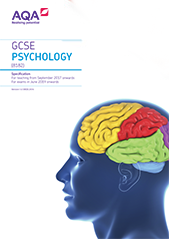3.1 Cognition and behaviour
Students will be expected to:
- demonstrate knowledge and understanding of psychological ideas, processes, procedures and theories in relation to the specified Paper 1 content
- apply psychological knowledge and understanding of the specified Paper 1 content in a range of contexts
- analyse and evaluate psychological ideas, information, processes and procedures in relation to the specified Paper 1 content and make judgements, draw conclusions and produce developments or refinements of psychological procedures based on their reasoning and synthesis of skills
- evaluate therapies and treatments including in terms of their appropriateness and effectiveness
- show how psychological knowledge and ideas change over time and how these inform our understanding of behaviour
- demonstrate the contribution of psychology to an understanding of individual, social and cultural diversity
- develop an understanding of the interrelationships between the core areas of psychology
- show how the studies for topics relate to the associated theory.
Knowledge and understanding of research methods (see Research methods), practical research skills and mathematical skills (see Appendix A: mathematical requirements) will be assessed across all topic areas in Paper 1. These skills should be developed by studying the specification content and through ethical, practical research activities, involving:
- designing research
- conducting research
- analysing and interpreting data.
By carrying out practical research activities, students will manage associated risks and use information and communication technology (ICT).
Memory
Content |
Additional information |
|---|---|
Processes of memory: encoding (input) storage and retrieval (output) |
Different types of memory: episodic memory, semantic memory and procedural memory. How memories are encoded and stored. |
Structures of memory |
The multi-store model of memory: sensory, short term and long term. Features of each store: coding, capacity, duration. Primacy and recency effects in recall: the effects of serial position. Murdock’s serial position curve study. |
Memory as an active process |
The Theory of Reconstructive Memory, including the concept of ‘effort after meaning’. Bartlett’s War of the Ghosts study. Factors affecting the accuracy of memory, including interference, context and false memories. |
Perception
|
Content |
Additional information |
|---|---|
|
Sensation and perception |
The difference between sensation and perception. |
|
Visual cues and constancies |
Monocular depth cues: height in plane, relative size, occlusion and linear perspective. Binocular depth cues: retinal disparity, convergence. |
|
Gibson's direct theory of perception – the influence of nature |
The real world presents sufficient information for direct perception without inference. Role of motion parallax in everyday perception. |
|
Visual illusions |
Explanations for visual illusions: ambiguity, misinterpreted depth cues, fiction, size constancy. Examples of visual illusions: the Ponzo, the Müller-Lyer, Rubin’s vase, the Ames Room, the Kanizsa triangle and the Necker cube. |
|
Gregory's constructivist theory of perception – the influence of nurture |
Perception uses inferences from visual cues and past experience to construct a model of reality. |
|
Factors affecting perception |
Perceptual set and the effects of the following factors affecting perception: culture, motivation, emotion, expectation. The Gilchrist and Nesberg study of motivation and the Bruner and Minturn study of perceptual set. |
Development
Content |
Additional information |
|---|---|
Early brain development |
A basic knowledge of brain development, from simple neural structures in the womb, of brain stem, thalamus, cerebellum and cortex, reflecting the development of autonomic functions, sensory processing, movement and cognition. The roles of nature and nurture. |
Piaget’s stage theory and the development of intelligence The role of Piaget’s theory in education |
Piaget’s Theory of Cognitive Development including concepts of assimilation and accommodation. The four stages of development: sensorimotor, pre-operational, concrete operational and formal operational. Application of these stages in education. Reduction of egocentricity, development of conservation. McGarrigle and Donaldson’s ‘naughty teddy study’; Hughes’ ‘policeman doll study’. |
The effects of learning on development |
Dweck’s Mindset Theory of learning: fixed mindset and growth mindset. The role of praise and self-efficacy beliefs in learning. Learning styles including verbalisers and visualisers. Willingham’s Learning Theory and his criticism of learning styles. |
Research methods
Content |
Additional information |
|---|---|
Formulation of testable hypotheses |
Null hypothesis and alternative hypothesis. |
Types of variable |
Independent variable, dependent variable, extraneous variables. |
Sampling methods |
Target populations, samples and sampling methods and how to select samples using these methods:
Strengths and weaknesses of each sampling method. Understanding principles of sampling as applied to scientific data. |
Designing research |
Quantitative and qualitative methods:
Strengths and weaknesses of each research method and types of research for which they are suitable. |
Correlation |
An understanding of association between two variables and the use of scatter diagrams to show possible correlational relationships. The strengths and weaknesses of correlations. Computation of formulae is not required. |
Research procedures |
The use of standardised procedures, instructions to participants, randomisation, allocation to conditions, counterbalancing and extraneous variables (including explaining the effect of extraneous variables and how to control for them). |
Planning and conducting research |
How research should be planned, taking into consideration the reliability and/or validity of:
|
Ethical considerations |
Students should demonstrate knowledge and understanding of:
|
Data handling
Content |
Additional information |
|---|---|
Quantitative and qualitative data |
The difference between quantitative and qualitative data. |
Primary and secondary data |
The difference between primary and secondary data. |
Computation |
Recognise and use expressions in decimal and standard form: use ratios, fractions and percentages, estimate results, find arithmetic means and use an appropriate number of significant figures. |
Descriptive statistics |
Understand and calculate mean, median, mode and range. |
Interpretation and display of quantitative data |
Construct and interpret frequency tables and diagrams, bar charts, histograms and scatter diagrams for correlation. |
Normal distributions |
The characteristics of normal distribution. |
